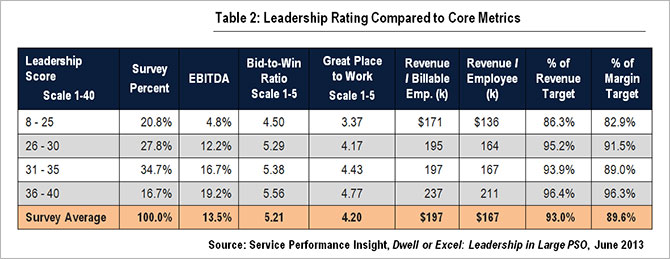
In today’s increasingly competitive market place, executive and delivery leadership within professional services firms are taking the time to step back and review their vision and refine their strategies. As the professional services market continues to show signs of growth, often these strategies relate to these business edicts:
- Create clear competitive advantage
- Seek continuous improvement
- Ensure that they align their sales operation with service delivery to drive successful outcomes and satisfied customers
In their latest white paper, Dwell or Excel: Leadership in Large Professional Services Organizations white paper, Service Performance Insight (SPI) compiles six years of benchmark research to highlight the importance of strong leadership (direction and bi-directional communication), with those having “high leadership scores” achieving:
- A greater bid-to-win ratio
- Higher revenue per billable resource
- Improved profitability
Whilst all firms create annual business plans, a key difference is that the leaders within the top firms live their plans all year long with a concentration on execution and monitoring performance.
For many professional services firms the disconnection between their sales teams (who are focused on achieving quarterly targets) and the services organization (who are juggling project delivery to multiple clients) causes significant problems in planning the right resources on new projects and understanding where to focus their recruitment efforts. This disconnect is often caused by poor communication, silos of information and operation inefficiencies.
Tackling the Disconnect Improves the Most Important KPIs
Service Performance Insight’s (SPI) report shows the importance of resolving these issues and achieving company-wide visibility into both demand and delivery. By having Customer Resource Management (CRM) and Services Resource Planning (SRP) systems in place, and ensuring they are integrated, leading firms focus on assigning the right resources to a project, enabling them to deliver high-quality, value-added services to their clients. The SPI research also shows that these leading firms have a higher percentage of referenceable clients which drives more repeat business and referrals and a better win-to-bid ratio.
For those professional services organizations surveyed by SPI over the past six years, at the highest echelon of key performance indicators is the billability of resources. This is likely because the optimization of the utilization of resources requires good visibility of:
- What they are working on today
- When they have availability
- What skills they have
- What work is in the pipeline
The survey data analyzed in the white paper, Dwell or Excel white paper, shows that the top 30 firms have a higher percentage of integration between their CRM, SRP and enterprise resource planning (ERP) systems, providing them with the information required to make better business decisions and improve the revenue per billable employee.
Specifically, the survey results suggest that only with clear visibility of resources can delivery leaders make informed resource planning decisions and successfully manage the peaks and troughs of demand while ensuring client delight remains high priority.
To learn more about this research, download the SPI white paper, Dwell or Excel: Leadership in the Large Professional Services Organization, for free here.




